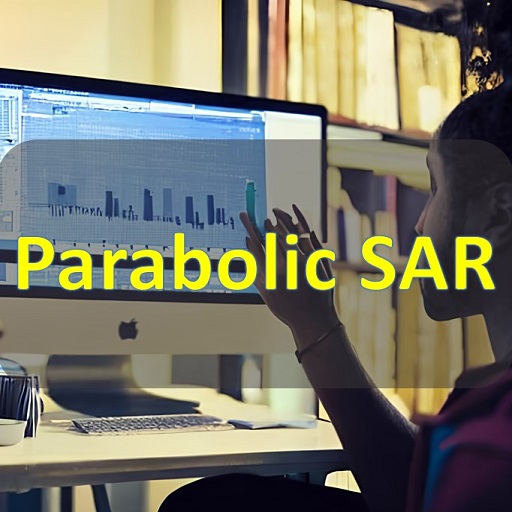Parabolic SAR (Stop and Reverse) is a popular technical analysis indicator used by traders to determine potential entry and exit points in financial markets. It was developed by J. Welles Wilder Jr. and is commonly applied to chart patterns in stocks, commodities, and forex markets.
The Parabolic SAR indicator helps identify trends and reversals in price movements. It appears as a series of dots placed above or below the price chart. When the dots are below the price, it suggests an uptrend, while dots above the price indicate a downtrend.
The calculation of Parabolic SAR involves two parameters: the acceleration factor (AF) and the extreme point (EP). The acceleration factor determines the rate at which the SAR moves closer to the price. Initially, the AF is typically set at 0.02 and increases by the same amount each time a new extreme point is reached.
During an uptrend, the Parabolic SAR dots start below the price and gradually move closer to it. If the price surpasses the SAR dot, the indicator reverses, and the dots appear above the price, signaling a potential reversal or the end of the uptrend.
In a downtrend, the Parabolic SAR dots begin above the price and move closer to it over time. If the price drops below the SAR dot, the indicator flips, and the dots appear below the price, indicating a potential reversal or the conclusion of the downtrend.
Traders commonly use the Parabolic SAR indicator in conjunction with other technical analysis tools to confirm signals and make informed trading decisions. It can be helpful for setting stop-loss orders, trailing stops, and identifying potential trend changes.
It’s important to note that like any technical indicator, Parabolic SAR is not foolproof and should be used in conjunction with other analysis techniques to increase the accuracy of trading decisions. It’s also crucial to consider other factors such as market conditions, fundamentals, and risk management when making trading choices.
Understanding the Parabolic SAR Indicator
The Parabolic SAR (Stop and Reverse) indicator is a technical analysis tool used by traders to identify potential trends and reversals in price movements. It helps determine optimal entry and exit points in financial markets such as stocks, commodities, and forex.
The Parabolic SAR indicator consists of a series of dots that appear above or below the price chart. When the dots are located below the price, it suggests an uptrend, while dots above the price indicate a downtrend.
To calculate the Parabolic SAR, two parameters are needed: the acceleration factor (AF) and the extreme point (EP). The AF determines the rate at which the SAR dots move closer to the price. Initially, the AF is usually set at 0.02 and increases by the same amount each time a new extreme point is reached.
During an uptrend, the Parabolic SAR dots start below the price and gradually move closer to it. If the price surpasses the SAR dot, the indicator reverses, and the dots appear above the price. This signals a potential reversal or the end of the uptrend.
In a downtrend, the Parabolic SAR dots begin above the price and move closer to it over time. If the price drops below the SAR dot, the indicator flips, and the dots appear below the price. This indicates a potential reversal or the conclusion of the downtrend.
Traders often combine the Parabolic SAR indicator with other technical analysis tools to confirm signals and make more informed trading decisions. It is commonly used for setting stop-loss orders, trailing stops, and identifying possible trend changes.
However, it’s important to remember that the Parabolic SAR indicator is not foolproof and should be used alongside other analysis techniques. It is also essential to consider other factors such as market conditions, fundamental analysis, and risk management to make well-rounded trading choices.
The Parabolic SAR (Stop and Reverse) indicator is a technical analysis tool used by traders to identify potential trends and reversals in price movements. It helps determine optimal entry and exit points in financial markets such as stocks, commodities, and forex.
The Parabolic SAR indicator consists of a series of dots that appear above or below the price chart. When the dots are located below the price, it suggests an uptrend, while dots above the price indicate a downtrend.
To calculate the Parabolic SAR, two parameters are needed: the acceleration factor (AF) and the extreme point (EP). The AF determines the rate at which the SAR dots move closer to the price. Initially, the AF is usually set at 0.02 and increases by the same amount each time a new extreme point is reached.
During an uptrend, the Parabolic SAR dots start below the price and gradually move closer to it. If the price surpasses the SAR dot, the indicator reverses, and the dots appear above the price. This signals a potential reversal or the end of the uptrend.
In a downtrend, the Parabolic SAR dots begin above the price and move closer to it over time. If the price drops below the SAR dot, the indicator flips, and the dots appear below the price. This indicates a potential reversal or the conclusion of the downtrend.
Traders often combine the Parabolic SAR indicator with other technical analysis tools to confirm signals and make more informed trading decisions. It is commonly used for setting stop-loss orders, trailing stops, and identifying possible trend changes.
However, it’s important to remember that the Parabolic SAR indicator is not foolproof and should be used alongside other analysis techniques. It is also essential to consider other factors such as market conditions, fundamental analysis, and risk management to make well-rounded trading choices.
Calculation and Interpretation of Parabolic SAR
The Parabolic SAR (Stop and Reverse) indicator is calculated and interpreted as follows:
1. Initial Calculation:
– Choose an initial extreme point (EP) and an initial acceleration factor (AF). The common default values are EP = the first day’s high or low and AF = 0.02.
– Set the SAR value for the first day as the EP.
2. Calculation for subsequent days:
– Calculate the SAR value for the current day using the following formula:
SAR(current) = SAR(previous) + AF(previous) * (EP(previous) – SAR(previous))
– If the trend is up, compare the current day’s SAR value with the lowest low of the past EP periods. Choose the lower value as the new SAR.
– If the trend is down, compare the current day’s SAR value with the highest high of the past EP periods. Choose the higher value as the new SAR.
– If the current day’s high or low surpasses the SAR value, it indicates a trend reversal. In such cases, flip the trend and recalculate the SAR and AF values.
3. Interpretation:
– When the SAR dots are below the price, it suggests an uptrend, and traders may consider buying or holding positions.
– When the SAR dots are above the price, it indicates a downtrend, and traders may consider selling or avoiding long positions.
– Reversals occur when the price crosses the SAR dot. In an uptrend, if the price crosses above the SAR dot, it suggests a potential reversal to a downtrend. In a downtrend, if the price crosses below the SAR dot, it indicates a potential reversal to an uptrend.
– Traders commonly use the Parabolic SAR in conjunction with other technical indicators or analysis tools to confirm signals and make trading decisions.
It’s important to note that the Parabolic SAR is not always suitable for all market conditions. It performs well in trending markets but may generate false signals in sideways or choppy markets. Traders should consider using the indicator alongside other tools and techniques to increase its effectiveness and reliability.
Using Parabolic SAR for Trend Identification
The Parabolic SAR (Stop and Reverse) indicator can be effectively used for trend identification in financial markets. Here’s how you can utilize it for this purpose:
1. Uptrend Identification:
– When the Parabolic SAR dots are located below the price, it indicates an uptrend. This means that the market is experiencing a series of higher highs and higher lows.
– Traders can interpret this as a signal to consider buying or holding positions in line with the upward trend.
– As long as the SAR dots remain below the price, the uptrend is considered intact.
2. Downtrend Identification:
– When the Parabolic SAR dots are positioned above the price, it suggests a downtrend. This means that the market is characterized by lower highs and lower lows.
– Traders may interpret this as a signal to consider selling or avoiding long positions, aligning with the downward trend.
– As long as the SAR dots remain above the price, the downtrend is considered intact.
3. Trend Reversals:
– The Parabolic SAR is also valuable in identifying potential trend reversals.
– If the price crosses above the SAR dot during an uptrend, it signifies a potential reversal to a downtrend.
– Conversely, if the price crosses below the SAR dot during a downtrend, it suggests a potential reversal to an uptrend.
– Traders may take these crossovers as indications to adjust their positions or consider entering trades in the direction of the new trend.
By using the Parabolic SAR for trend identification, traders can gain insights into the prevailing market direction and make informed decisions regarding their trading strategies. However, it’s crucial to complement the indicator with other analysis techniques and tools to confirm trends and minimize false signals. Additionally, considering risk management and market conditions is vital for successful trading.
Incorporating Parabolic SAR with Other Indicators
Incorporating the Parabolic SAR (Stop and Reverse) indicator with other technical indicators can enhance your trading analysis and provide more robust signals. Here are a few commonly used approaches:
1. Moving Averages:
– Combining the Parabolic SAR with moving averages can help confirm trend directions and potential reversals.
– For an uptrend confirmation, the Parabolic SAR dots should be below the price, and the price should be above a rising moving average (such as the 50-day or 200-day moving average).
– For a downtrend confirmation, the Parabolic SAR dots should be above the price, and the price should be below a declining moving average.
– Crossovers between the Parabolic SAR and moving averages can provide additional signals for trend changes or trend strength.
2. Relative Strength Index (RSI):
– The RSI is a momentum oscillator that measures the speed and change of price movements.
– Combining the Parabolic SAR with the RSI can help identify overbought or oversold conditions in the market.
– In an uptrend, if the Parabolic SAR indicates a potential reversal, and the RSI shows overbought conditions (RSI above 70), it could be a signal to consider taking profits or selling.
– In a downtrend, if the Parabolic SAR indicates a potential reversal, and the RSI shows oversold conditions (RSI below 30), it could be a signal to consider buying or taking long positions.
3. Moving Average Convergence Divergence (MACD):
– The MACD is a trend-following momentum indicator that helps identify potential trend changes.
– Combining the Parabolic SAR with MACD crossovers can strengthen trend reversal signals.
– In an uptrend, if the Parabolic SAR indicates a potential reversal, and the MACD line crosses below the signal line, it could indicate a stronger bearish signal.
– In a downtrend, if the Parabolic SAR indicates a potential reversal, and the MACD line crosses above the signal line, it could indicate a stronger bullish signal.
Remember, incorporating multiple indicators does not guarantee accuracy, and it’s essential to consider market conditions, fundamental analysis, and risk management. Traders should test and optimize their indicator combinations to find the most effective approach for their trading strategies.
Parabolic SAR as a Stop Loss Tool
The Parabolic SAR (Stop and Reverse) indicator can be effectively used as a tool for setting stop-loss orders in trading. Here’s how you can utilize it for this purpose:
1. Trailing Stop-Loss:
– As the Parabolic SAR moves in the direction of the trend, it can serve as a trailing stop-loss mechanism to protect profits and limit potential losses.
– In an uptrend, the SAR dots are positioned below the price. Traders can set their stop-loss orders just below the SAR dots.
– As the price continues to rise, if the SAR dots move higher, the stop-loss order can be adjusted accordingly to protect a larger portion of profits.
– This trailing stop-loss approach allows traders to stay in a position as long as the trend remains intact but provides an exit strategy if the trend reverses.
2. Reversal Stop-Loss:
– The Parabolic SAR can also be used to set stop-loss orders when a trend reversal is signaled.
– In an uptrend, if the price crosses below the SAR dot, it suggests a potential trend reversal. Traders can set their stop-loss orders just below the SAR dot to exit the position.
– Similarly, in a downtrend, if the price crosses above the SAR dot, it indicates a potential reversal. Traders can set their stop-loss orders just above the SAR dot to exit the position.
– This approach helps protect against losses in case the trend reverses and allows traders to exit their positions before significant drawdowns occur.
Using the Parabolic SAR as a stop-loss tool can help traders manage risk by defining exit points based on the indicator’s signals. However, it’s important to consider other factors such as market conditions, volatility, and individual risk tolerance when determining the appropriate placement of stop-loss orders. Additionally, regularly monitoring and adjusting stop-loss levels as the trend progresses can be crucial for effective risk management.
Combining Parabolic SAR with Fundamental Analysis
Combining the Parabolic SAR (Stop and Reverse) indicator with fundamental analysis can provide a comprehensive approach to trading or investing. Here’s how you can incorporate both:
1. Identify Key Fundamental Factors:
– Conduct thorough fundamental analysis to assess the underlying factors influencing the asset’s value.
– Consider economic indicators, company financials, industry trends, news events, and other relevant factors that impact the asset’s fundamentals.
– Determine whether the asset is undervalued or overvalued based on fundamental analysis.
2. Use Parabolic SAR for Timing and Risk Management:
– Once you have established a fundamental view on the asset, employ the Parabolic SAR for timing entry and exit points.
– If the fundamental analysis suggests a bullish outlook for the asset, you can use the Parabolic SAR to identify potential entry points during uptrends or trend reversals to maximize profit potential.
– Conversely, if the fundamental analysis suggests a bearish outlook, the Parabolic SAR can help identify potential short-selling opportunities or exit points during downtrends or trend reversals.
– Set stop-loss orders based on the Parabolic SAR signals to manage risk and protect against adverse price movements.
3. Combine Signals for Confirmation:
– Look for confirmation between the Parabolic SAR signals and supporting fundamental factors.
– If the Parabolic SAR indicates a potential trend reversal, evaluate whether any fundamental factors align with that reversal signal.
– A convergence of technical signals from the Parabolic SAR and supporting fundamental factors can strengthen the validity of a trading decision.
Remember, fundamental analysis provides a long-term perspective on an asset’s value, while the Parabolic SAR focuses on short-term trends and reversals. By combining both approaches, you can benefit from a well-rounded analysis, considering both the underlying value of the asset and the timing of entry and exit points.
However, it’s important to note that no trading strategy or analysis technique is foolproof. It’s essential to continuously monitor and adapt your approach based on new information, market conditions, and risk management principles.







